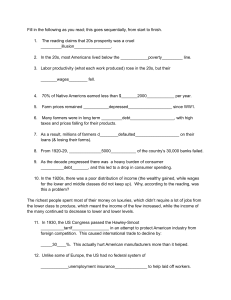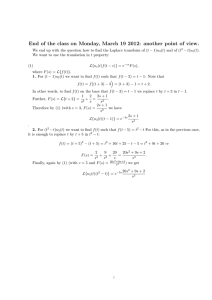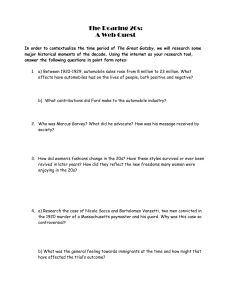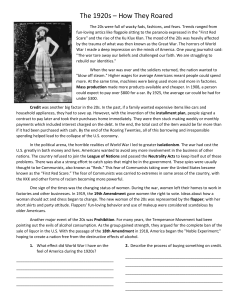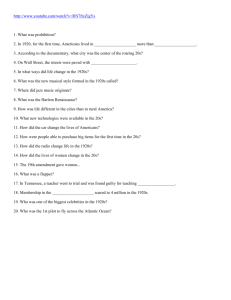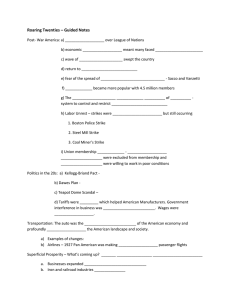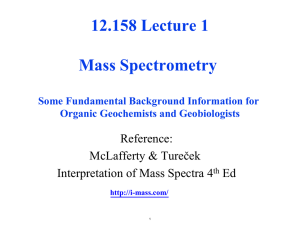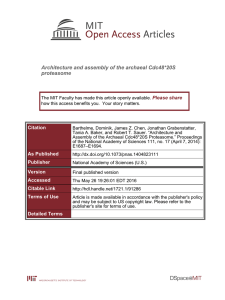( )
advertisement
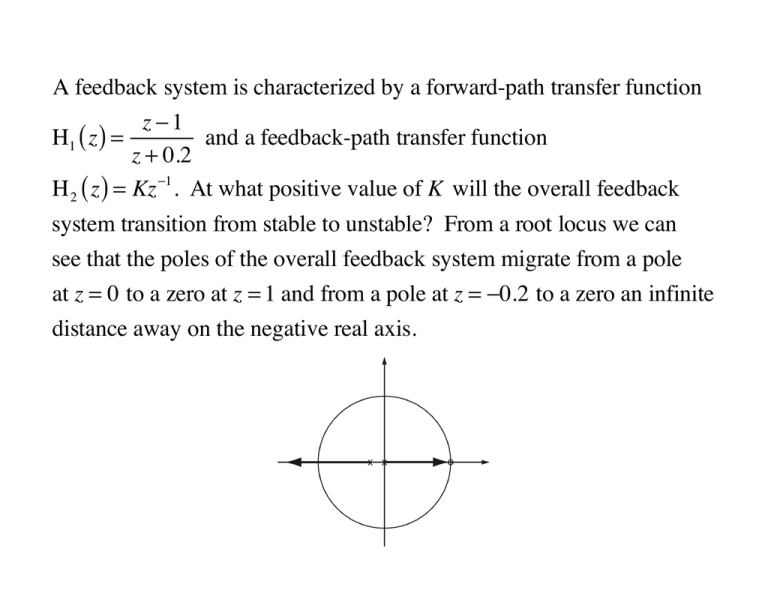
A feedback system is characterized by a forward-path transfer function z −1 H1 ( z ) = and a feedback-path transfer function z + 0.2 H 2 ( z ) = Kz −1 . At what positive value of K will the overall feedback system transition from stable to unstable? From a root locus we can see that the poles of the overall feedback system migrate from a pole at z = 0 to a zero at z = 1 and from a pole at z = −0.2 to a zero an infinite distance away on the negative real axis. Using the feedback formulas we get z −1 z ( z − 1) z ( z − 1) z + 0.2 H (z) = = = 2 K ( z − 1) z ( z + 0.2 ) + K ( z − 1) z + ( 0.2 + K ) z − K 1+ z ( z + 0.2 ) This system has poles at z 2 + ( 0.2 + K ) z − K = 0 −0.2 − K ± 0.04 + 0.4K + K 2 + 4K or z = 2 = −0.1 − K / 2 ± 0.01 + 1.1K + K 2 / 4 We know one of the poles must leave the unit circle at z = −1. If we choose the negative sign on the square root and set z = −1 we get − 0.1 − K / 2 − 0.01 + 1.1K + K 2 / 4 = −1 Solving, K = 0.4 and this must be the positive value of K we seek. If we choose the positive sign on the square root and set z = −1 we get − 0.1 − K / 2 + 0.01 + 1.1K + K 2 / 4 = −1 0.01 + 1.1K + K 2 / 4 = −0.9 + K / 2 Squaring both sides we get 0.01 + 1.1K + K 2 / 4 = 0.81 − 0.9K + K 2 / 4 and that leads to an apparent solution K = 0.4. But how can K = 0.4 yield an equality for both signs in −0.1 − K / 2 ± 0.01 + 1.1K + K 2 / 4 = −1 ? The answer is, it cannot. If we substitute K = 0.4 into −0.1 − K / 2 + 0.01 + 1.1K + K 2 / 4 we get −0.1 − K / 2 + 0.01 + 1.1K + K 2 / 4 = 0.4, not − 1. In solving for K by squaring both sides of 0.01 + 1.1K + K 2 / 4 = −0.9 + K / 2 we found a solution of 0.01 + 1.1K + K 2 / 4 = 0.81 − 0.9K + K 2 / 4 or 0.01 + 1.1K = 0.81 − 0.9K but not of − 0.1 − K / 2 + 0.01 + 1.1K + K 2 / 4 = −1. Rise time is defined as the time required for a system response to a step to rise from 10% of its final value to 90% of its final value. Find the rise time of the system whose transfer function is 200 H (s) = 2 . The Laplace transform of the unit step response s + 20s + 200 200 1 s + 20 is H −1 ( s ) = = − 2 and the step 2 s s + 20s + 200 s s + 20s + 200 ( ) response is h −1 ( t ) = ⎡⎣1 + 1.414e−10t cos (10t + 2.3562 ) ⎤⎦ u ( t ) . The final value is 1. So we need to find solutions to h −1 ( t10% ) = 0.1 and h −1 ( t 90% ) = 0.9. We can only find the solutions numerically because the equation is transcendental. Rise Time is 151.9 ms Now let the system be the forward path in a unity-gain feedback system and find the rise time of the overall feedback system. 200 200 H1 ( s ) = 2 ⇒ H (s) = 2 s + 20s + 200 s + 20s + 400 200 0.5 0.5s + 10 H −1 ( s ) = = − 2 2 s s + 20s + 400 s s + 20s + 400 ( ) h −1 ( t ) = ⎡⎣ 0.5 + 0.57735e−10t cos (17.3205t + 2.618 ) ⎤⎦ u ( t ) Rise Time is 81.9 ms Unity-gain feedback reduced the rise time by almost 50%. Design a digital notch filter to remove a signal at a frequency Ω = 0.8 by placing zeros on the unit circle at Ω = ±0.8 and poles at the same angles but slightly inside the unit circle. Graph its frequency response. z − e )( z − e ( ) H (z) = = ( z − 0.95e )( z − 0.95e ) z j 0.8 j 0.8 − j 0.8 − j 0.8 z 2 − 1.3934z + 1 2 − 1.3237z + 0.9025 Now let the transfer function be the forward path in a unity-gain feedback system and graph the frequency response of the overall feedback system. z 2 − 1.3934z + 1 z 2 − 1.3934z + 1 H1 ( z ) = 2 ⇒ H ( z ) = 0.5 2 z − 1.3237z + 0.9025 z − 1.359z + 0.9512 The notch in the feedback system's frequency response is "sharper" than the notch in the original system's frequency response.
